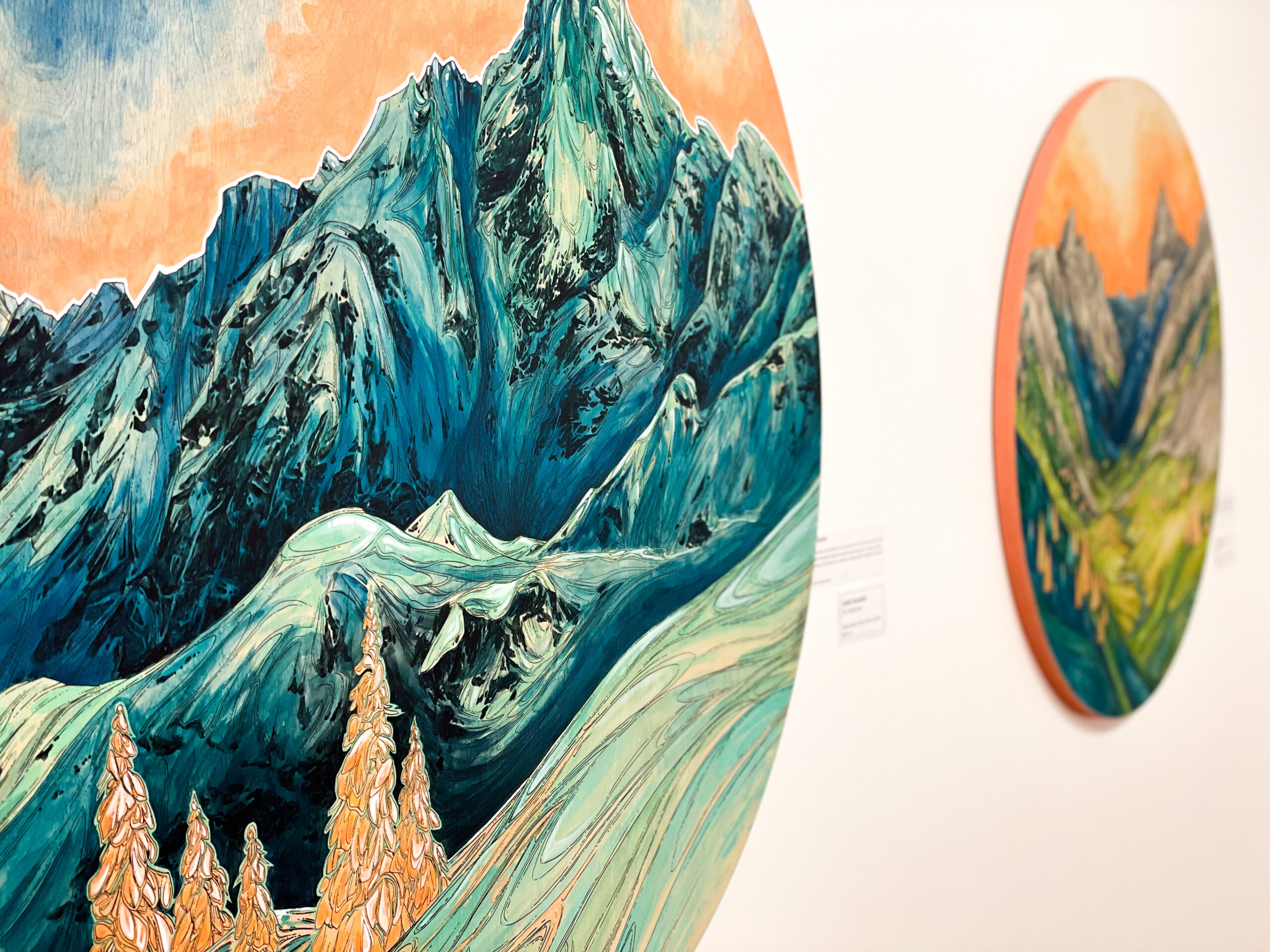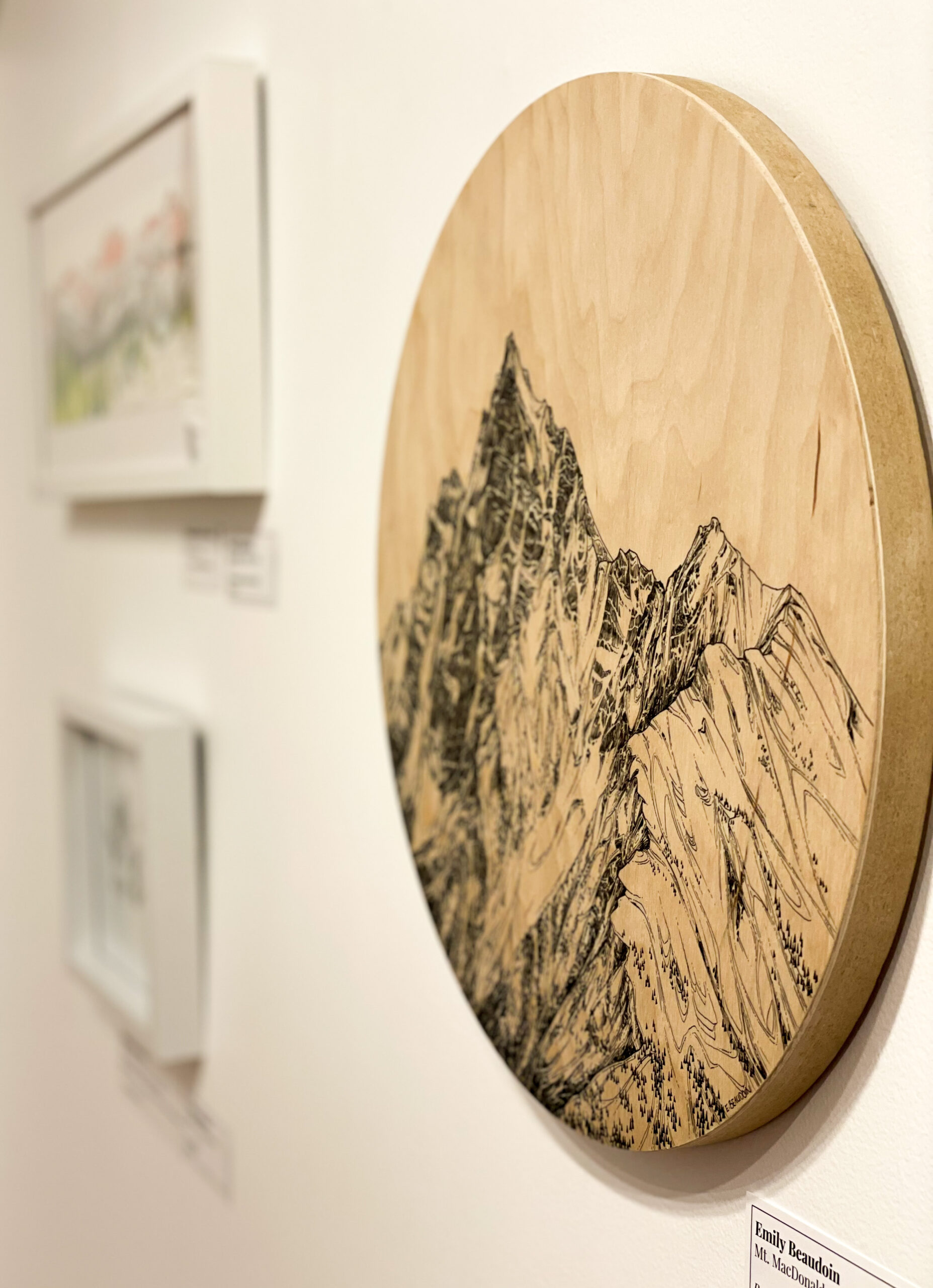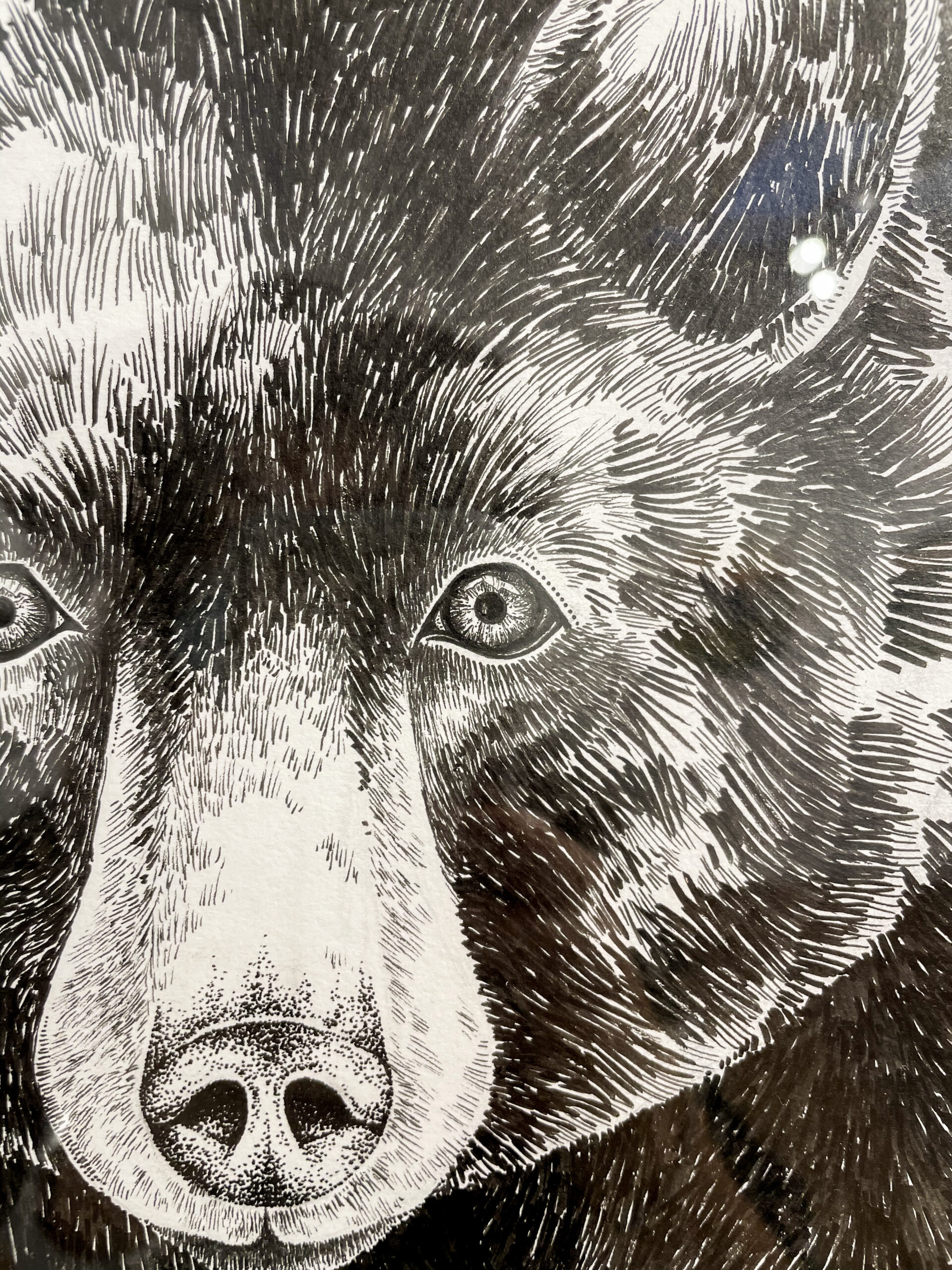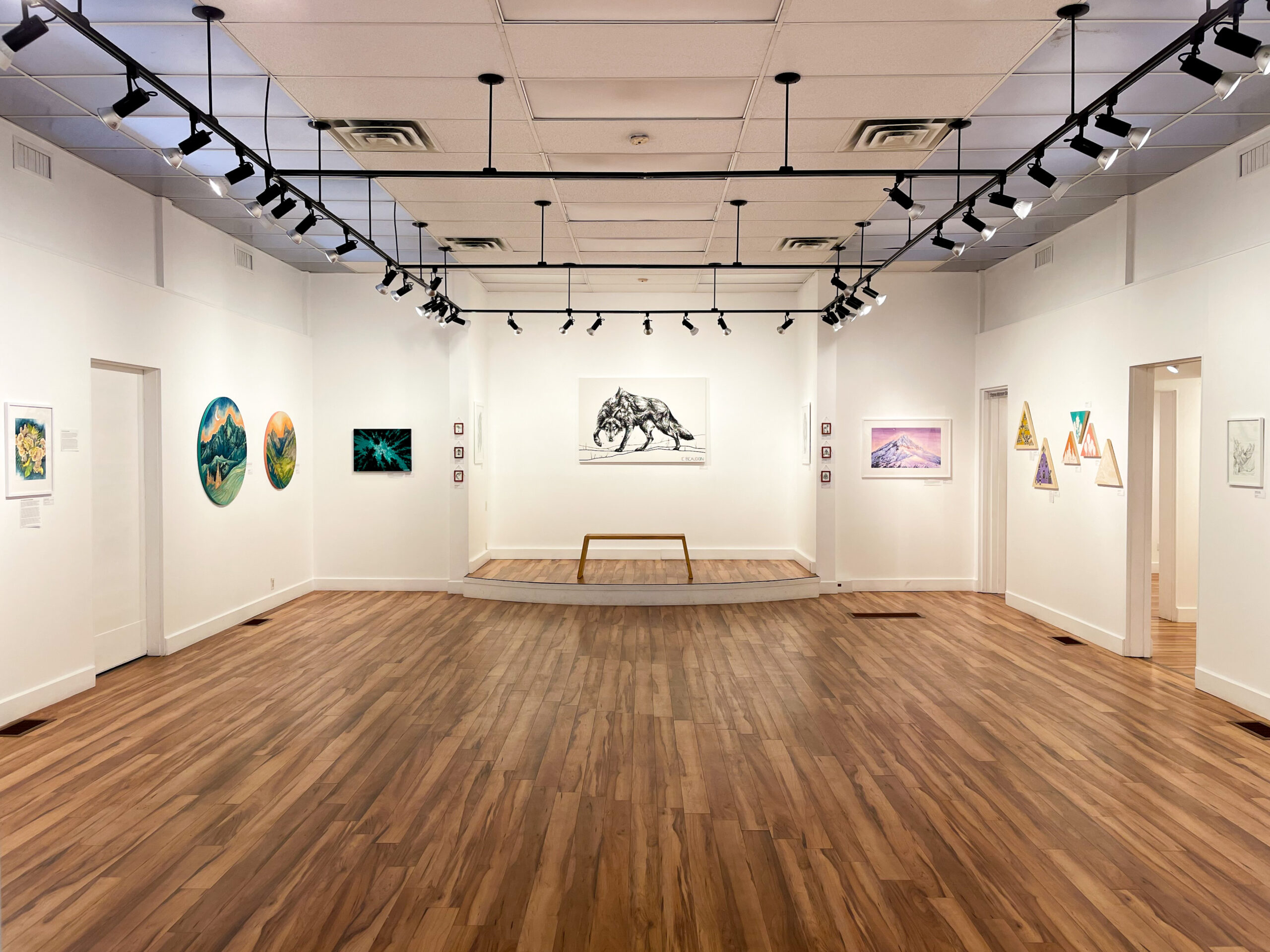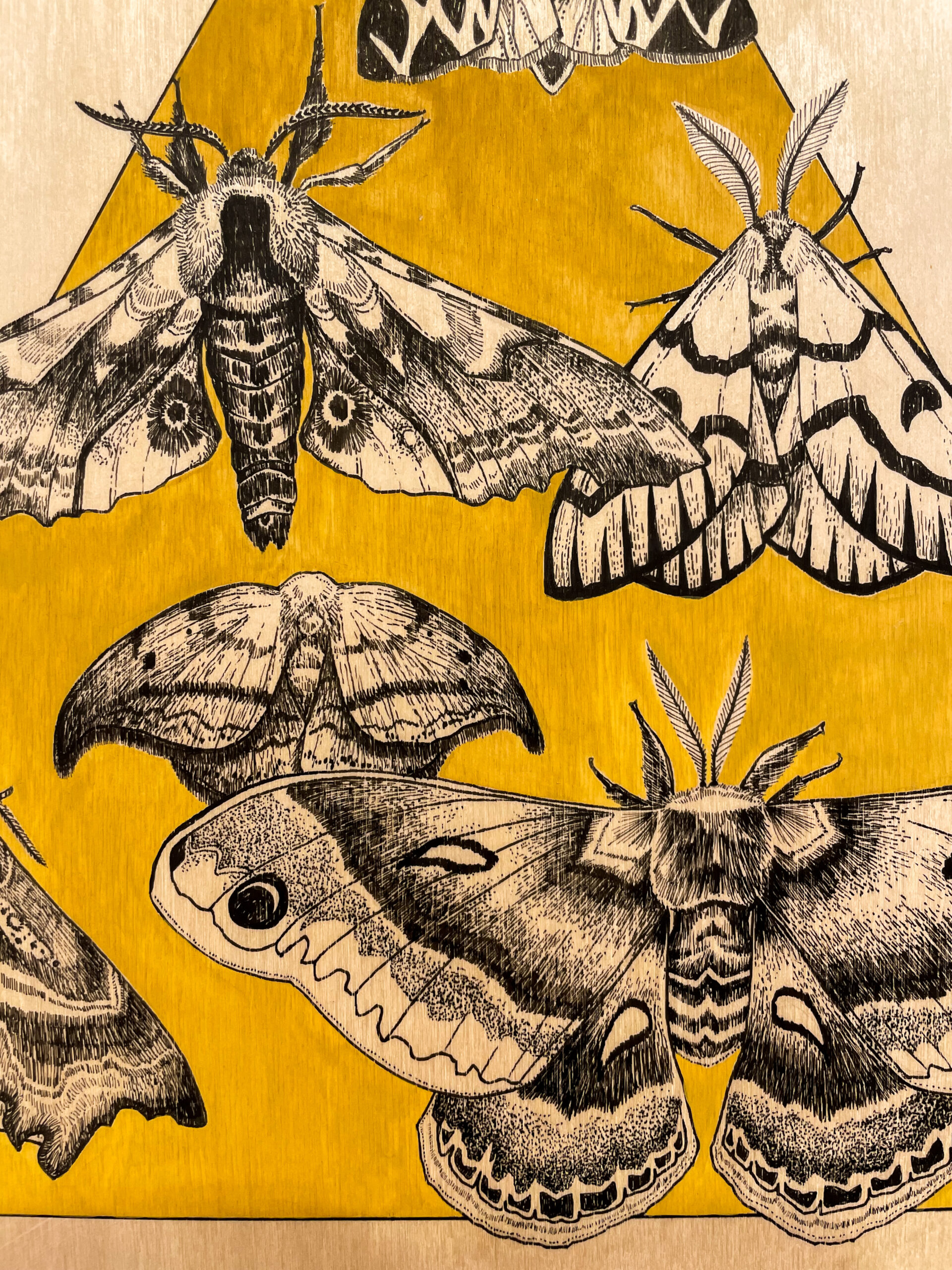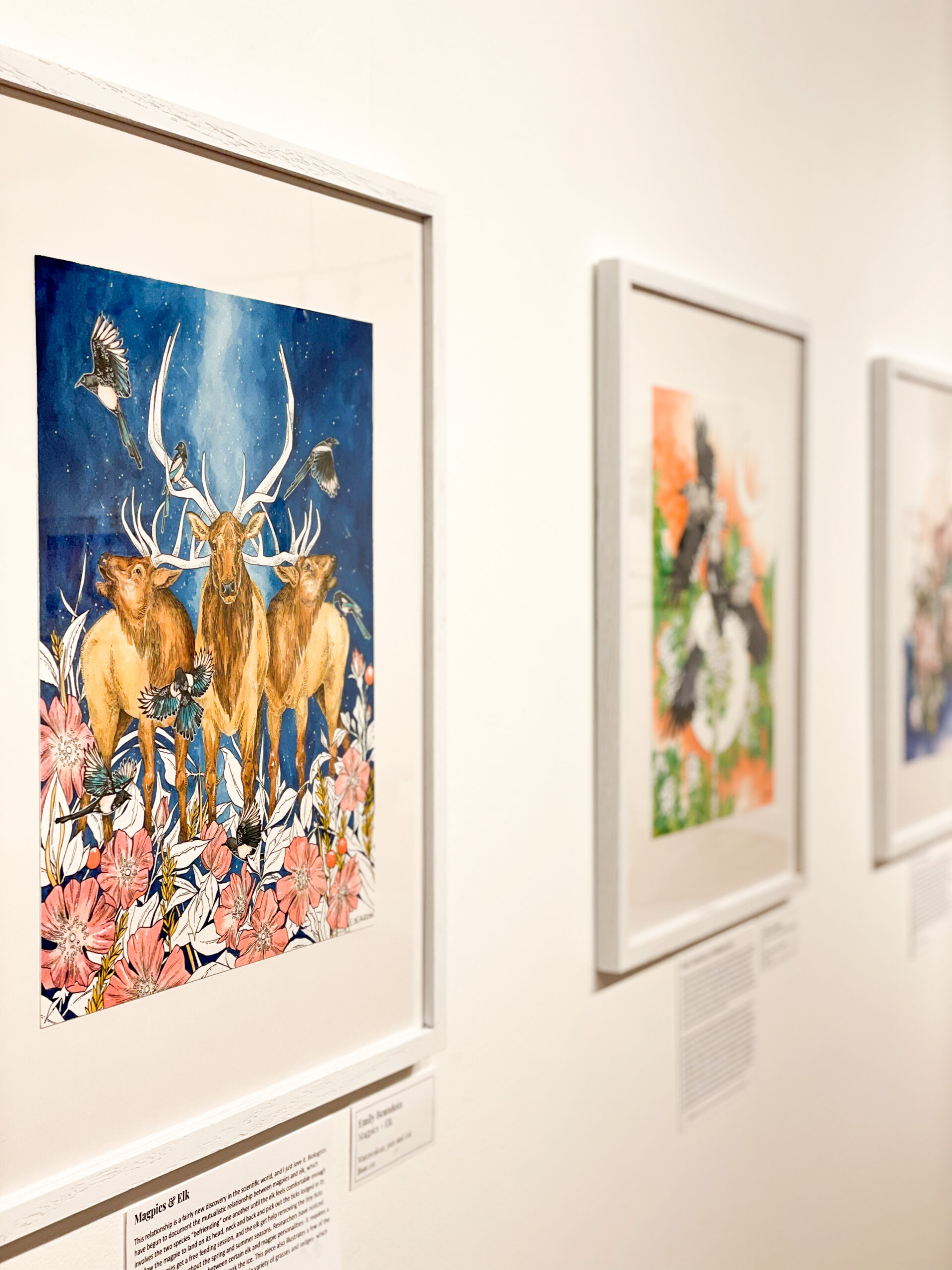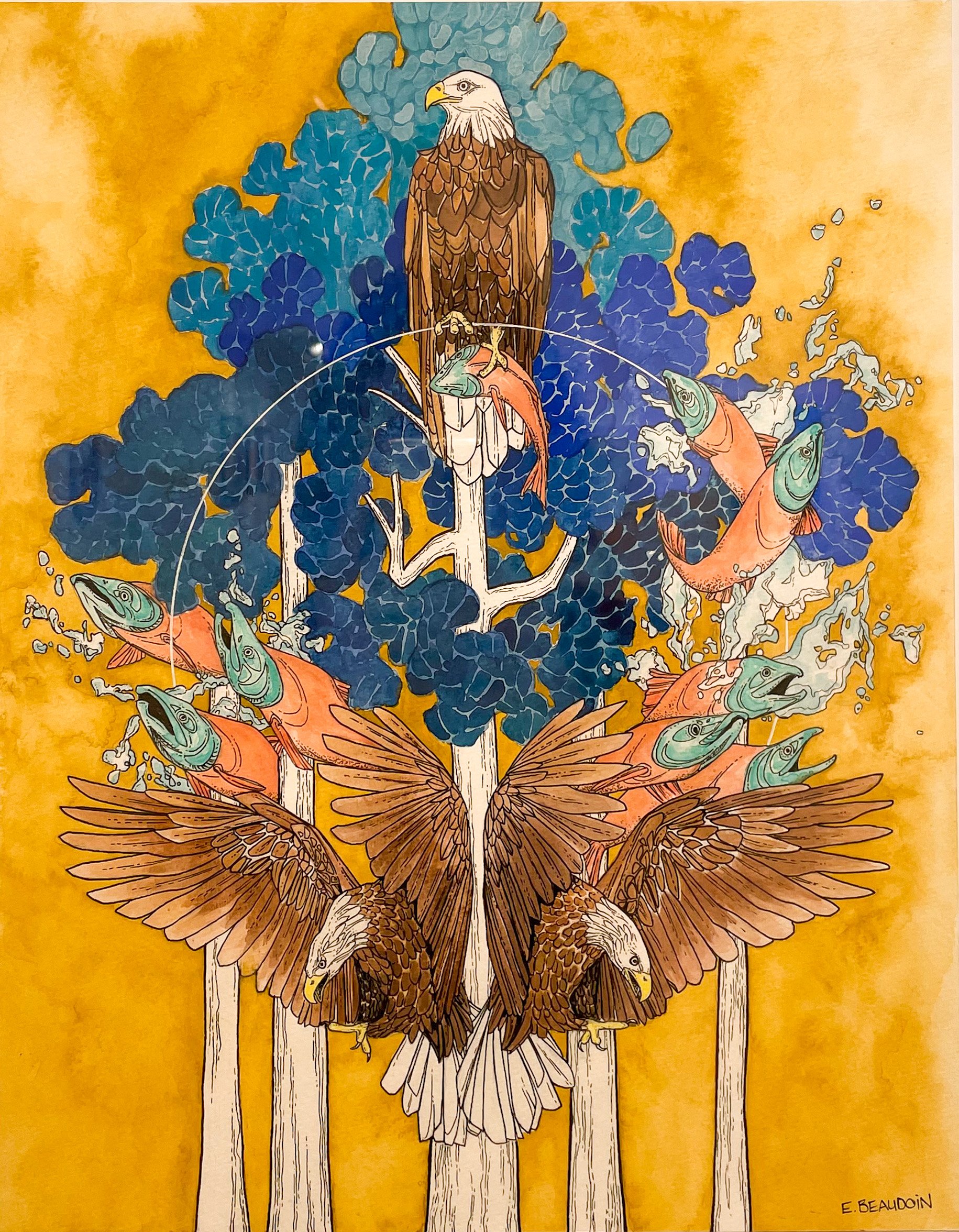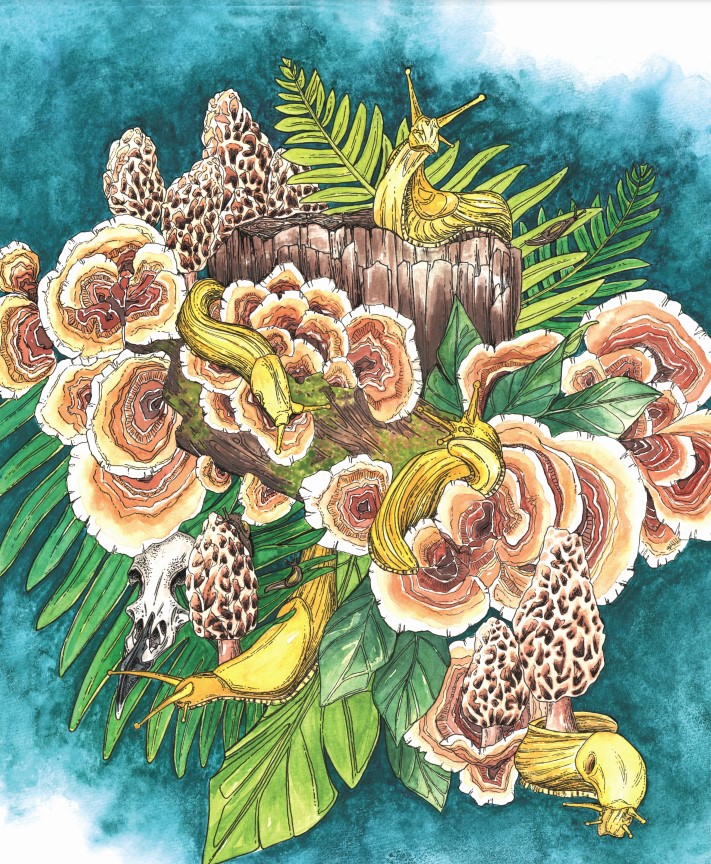Take the online virtual tour here.
Emily Beaudoin is a full-time, self-taught artist and muralist living in Revelstoke, BC. Her work is inspired and informed by the mountain eco-systems she lives in, travels to and continually learns from. Emily works in watercolour, pen and ink and acrylics, and spends her time painting in the mountains en plein air or in her studio. She is passionate about sharing her love of art with others, and has given multiple talks about en plein air painting and art as a form of environmental stewardship. She also teaches watercolour classes and runs women’s backcountry art retreats.
‘The Wilds’ explores ecosystem interactions in the mountain environments of western Canada, from mega fauna such as wolves and bears to the less celebrated, but equally as vital organisms like slugs, beetles and mushrooms. There are several series within this body of work, including six paintings illustrating a number of symbiotic relationships between mountain organisms, each telling a story of how these species co-exist, help one another survive, and contribute to the overall health of the eco-system. The collection of landscapes painted and drawn in a variety of mediums shows a larger scale view of the wild places which hold so much life within them. Finally, an ode to the invertebrates, mushrooms, and wildflowers of BC brings us closer to the ground to examine the beauty and intricacies of the smaller residents of the wilderness. Together these series provide an in-depth look at the mountain environments we are lucky enough to live in, and each piece is imbibed with the love I have for every aspect of this intricate web of life.
I hope this show brings you from highest peaks to forest floors, riverbanks to alpine meadows, hot, sticky blueberry patches to the sprawling stars of the milky way. For me, the mountains are places full of magic, colour, wind, light, and ruthless beauty, and I strove to bring those elements into every piece I created. I spent hundreds of hours creating this body of work, and it truly was a joy to watch it come to life and to be able to share it with you now. If it brings you a sense of joy and a deepened understanding of and connection to our mountains, I have accomplished what I set out to do. Thank you for coming, and enjoy The Wilds.
– Emily Beaudoin
Artist Biography
Emily Beaudoin is a full-time, self-taught artist and muralist living in Revelstoke, BC. Her work is inspired and informed by the mountain eco-systems she lives in, travels to and continually learns from. Emily works in watercolour, pen and ink and acrylics, and spends her time painting in the mountains en plein air or in her studio. She is passionate about sharing her love of art with others, and has given multiple talks about plein air painting and art as a form of environmental stewardship, as well as teaching watercolour classes and running women’s backcountry art retreats. Emily is currently involved with the filming of a documentary called “Rockies Repeat”, following six emerging female artists re-creating the 100 year old paintings of Catharine Robb Whyte as a dialogue on glacial recession and climate change. Emily has been fortunate to show her work throughout western Canada, as well as painting a number of murals in Canmore, Calgary and Banff. You can view more of Emily’s work at www.emilybeaudoin.com
Symbiosis Series Statement
This series is very near and dear to my heart. Since I was a little girl, I was always on the hunt for stories that could explain the world around me. I particularly loved learning about nature in this way, and found that I could remember facts, connections, and species better if there had been some kind of story involved. I was fascinated when we learned about symbiosis in an elementary school science class, and loved the concept that different species interacted with one another in such an intentional way.
Symbiosis is defined as an evolved interaction or close living relationship between organisms from different species, usually with benefits to one or both of the individuals involved. In recent years, the definition has expanded from the original ‘mutualism’ (both species benefiting from the interaction) to include commensalism (one species depends on the host for food, shelter, or locomotion, with no obvious effect on the host), predation (one species kills and feeds on another), parasitism (one species benefits at the expense of another), and competition (when one species excludes another from its food source or shelter). Several of these forms of symbiosis are illustrated in the following six paintings, which were lovingly researched and combined to form the intertwining compositions you are about to see. Each piece took between 21-24 hours to complete, from research, collecting reference photos, creating the compositions, sketching, watercolour and finally pen and ink.
Magpies & Elk
This relationship is a fairly new discovery in the scientific world, and I just love it. Biologists have begun to document the mutualistic relationship between magpies and elk, which involves the two species “befriending” one another until the elk feels comfortable enough to allow the magpie to land on its head, neck and back and pick out the ticks lodged in its skin. The magpies get a free feeding session, and the elk get help removing the tiny ticks that plague them throughout the spring and summer seasons. Researchers have noticed that the relationship only exists between certain elk and magpie personalities- it requires a calm and shy elk, and a bold magpie to break the ice. This piece also illustrates a few of the preferred food sources for elk- wild roses and a wide variety of grasses and sedges- which also happen to be where they pick up the ticks from.
Available as an 11×14” print. Contact the artist for alternate print sizing
Bees, Bears & Blueberries
Bees and wildflowers are maybe the most classic example of symbiotic mutualism. Bees have been intentionally pollinating flowers for around 120 million years- a relationship which provides the bees with pollen and nectar to feed on, and flowers with cross-pollination in order to reproduce. The wild blueberry bushes that grow all over the local mountain sides are particularly dependent on bee pollination, as they have heavy pollen encased in perforated “poricidal anthers”, which the pollen must be shaken out of like a salt shaker. (Most flowers have pollen that is much more easily accessible for pollinators, and can even be blown about by the wind). To pollinate a blueberry flower, the bee must crawl inside, grab the base of the anther in their mouths and rapidly vibrate their jaw muscles at 440 Hz, which causes the pollen to come pouring out. This is called buzz pollination, and is a skill specific to bumble bees and other wild bee species. Honey bees cannot buzz pollinate, so the presence of native bees such as the half-black bumble bee, Bombus vagans and the threatened western bumble bee, Bombus occidentalis– which are the bees in this painting- are especially important in the pollination of wild plants and berries, and need to be protected and conserved.
Bears also have an important mutualistic relationship with blueberry bushes- once the flowers have been pollinated by the bees and turned into berries, the bears strip the berries off the branches using their extremely agile and sticky tongues (which allow them to remove only the berries, leaving the branches and leaves behind!) They then roam to a new location, excreting the seeds and allowing blueberry patches to take root in new locations. All together, these three species make an excellent summertime team, and ensure that the blueberry population which is so important for so many species remains healthy and viable.
Available as an 11×14” print. Contact the artist for alternate print sizing
Clark’s Nutcrackers & Whitebark Pine
This symbiotic relationship might be my favourite of all. Whitebark pine, Pinus albicaulis, is a threatened tree species which grows in the upper subalpine to timberline regions of the mountains. It produces large cones containing fatty, nutritious seeds which carry more energy than chocolate per unit of weight. Needless to say, these seeds are very sought after, which is lucky for the pines, as they do not have a method of spreading the seeds themselves. The seeds are large and wingless, with no chance of being carried away on the wind. The cones also rarely open; and even if they did, the round seeds would drop directly to the base of the tree and be quickly eaten by rodents.
Here’s where the Clark’s nutcracker comes in. Extremely intelligent, they are a relative of jays and crows. They have several adaptations which allow them to get to the seeds, including a heavy, hooked bill and a hole under their tongue leading to a sublingual pouch where they can carry up to 50 seeds at a time. The most impressive adaptation however, is their high level of intelligence and strong spatial memory. After collecting a pouchful of seeds, nutcrackers fly across vast landscapes and select distinctive places to store their seeds. They bury 1-15 seeds in a “cache,” which is 1-2 centimeters deep. Typically, they will make 10,000 to 20,000 caches annually, and recover 50-80% of the seeds, depending on the size of the cone crop and the energy needs of the bird. This leaves a large portion of cached seeds free to germinate and create future whitebark pine forests in places the seeds would never have reached without the help of the Clark’s nutcracker.
Available as an 11×14” print. Contact the artist for alternate print sizing
Eagles, Salmon & Trees
The relationship between eagles, salmon and cedar is staggering is it’s importance. Every year, salmon make the exhausting run upriver to their natal streams (the streams where they were born). Many animals eagerly assemble on the river banks to await their return, and among them are the bald eagles. The feeding frenzy is wild, and the bodies of the large, nutrient rich fish are scattered throughout the forest and river bank, where they are broken down into life-giving nitrogen, phosphorous and other nutrients. Researchers have found that up to 70% of the nitrogen found in riparian zone foliage comes from salmon, and that trees growing on the banks of salmon-stocked rivers grow more than three times faster than those without. Sitka spruce growing near salmon rivers take 86 years, rather than the usual 300, to reach 50cm thick.
The salmon in turn benefit from the trees, which enrich the streams for aquatic life by shading the eggs, shedding insects off their branches for the young salmon fry to feed on and stabilizing the riverbanks with their roots. Trees also fall into the streams on occasion, creating calm, sheltered waters for the young salmon to hide and rest in, as well as directing stream flow and storing and distributing nutrients and sediment.
The salmon run attracts thousands of eagles to the banks of BC rivers every year, where their populations are bolstered by the surge of nutrients and fat provided by the fish.
They use the towering trees for shelter, nesting and hunting perches, and play their part by spreading the salmon remains throughout the forest.
Available as an 11×14” print. Contact the artist for alternate print sizing
Lynx & Snowshoe Hares
This piece illustrates the dramatic and well-known boom and bust predation cycle between snowshoe hares and lynx, as well as some of the winter plants that snowshoe hares live on, including juniper, Labrador tea, and jack pine. Snowshoe hares are the primary food source for lynx, whose population and reproduction rates are directly linked to the number of hares in the ecosystem. Hare populations experience drastic fluctuations in a cycle that lasts 8-11 years. At the peak of the cycle, snowshoe hares can reach a density of up to 1500 animals per square kilometer. Needless to say, the habitat cannot support this many animals, and starvation sets in. At this point, the lynx are having a hay day, and their population is increasing. Between starvation and increased lynx predation, the hare population starts to decline. There is a 1-2 year lag for the lynx population to follow, as they are able to easily prey on the starving hares, but eventually they feel the hunger as well, and are unable to successfully reproduce. This low population level lasts for 3-4 years, allowing the hares to become plentiful once again, and the whole cycle starts all over again.
Contact the artist for prints
Slugs, Mushrooms & Decomposition
Many people wrinkle their noses in disgust (or frustration, if they’re gardeners), when they think about slugs, but these little gastropods play a very important role in the boreal forest ecosystem. This piece has two species of slug- the showy banana slug, Ariolimax columbianus, and the smaller dromedary jumping slugs, Hemphillia dromedarius, which wriggle, leap and writhe violently if attacked, unlike most of their slower moving relatives, and are threatened.
Slugs are highly important decomposers, and will eat a wide variety of food found strewn about the forest floor including fresh and rotting plant matter, animal droppings, moss, carrion, and mushrooms, which are their favourite. Slugs eat a wide variety of mushrooms, including the morels and turkey tails portrayed in this piece. They have a keen sense of smell that leads them to patches all over the forest, and are able to devour mushrooms that are fatally poisonous to other wildlife and humans with ease. But slugs don’t just eat the mushrooms- they also help spread spores throughout the forest by excreting them in their fecal strings. After digesting the wide variety of food they have cleaned up off the forest floor, they excrete nutrient dense feces (often with mushroom spores in it), which fertilizes healthy soil and sets the next growth of mushrooms and plants up for success.
Slugs are also famous for their slime, which does not leave their bodies as mucus as many might think, but as tiny crystals which expand to 100 times their volume the moment they come into contact with water. Their slime is considered a liquid crystal, a substance somewhere between a solid and a liquid, and can be both lubricating and adhesive to match the slugs’ needs. When the forest is particularly dry, the slugs are in danger of drying up, so roll into a ball and wrap themselves in leaves in order to conserve moisture until the next rain comes.
Available as an 11×14” print. Contact the artist for alternate print sizing

